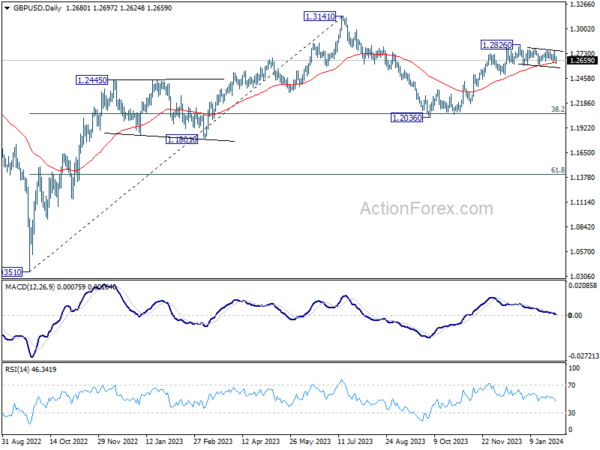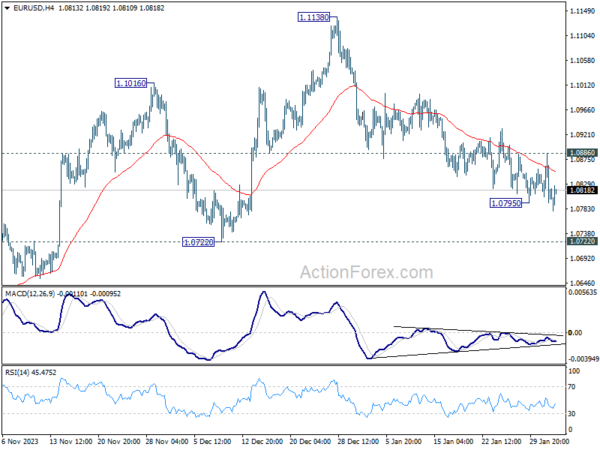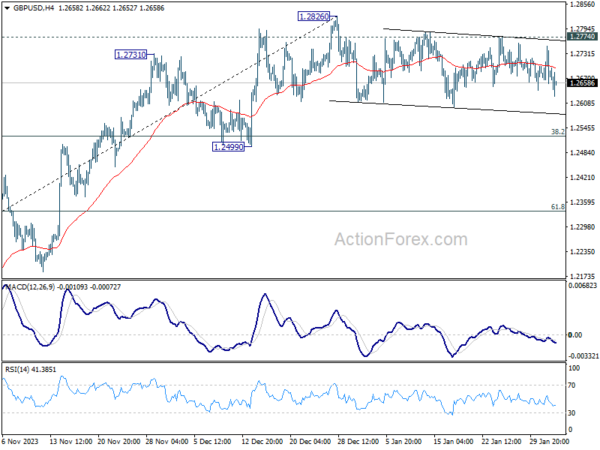Sterling is currently trading with indecisiveness following BoE’s rate decision, which has provoked mixed reactions in the markets. The decision, notable for its combination of hawkish and dovish signals, resulted in a rare three-way voting split—the first occurrence since 2008—with two members favoring a rate hike, one a cut, and the rest opting for no change. This split highlights the complexities and differing perspectives within the MPC.
BoE has notably relinquished its tightening bias, and significantly lowering the conditioned rate path, which now sees interest rate to fall to 3.9% by the onset of next year. Despite this dovish tilt, the bank simultaneously revised its inflation forecasts upward, suggesting that inflationary pressures will persist above target until 2026. Governor Andrew Bailey’s remarks were also clear in that the central bank is not yet in a position to contemplate rate reductions.
Meanwhile, Japanese Yen continues to assert its strength, capitalizing on weakening global benchmark yields. US 10-year yield is teetering on the brink of falling below the 3.9% mark, while its UK counterpart exhibits a similar downward trajectory. German 10-year yield, is merely holding its ground, lacking the momentum for a significant recovery.
Euro, the second strongest for the day after Yen, finds itself buoyed slightly by higher than expected inflation readings in both the headline and core CPI in Eurozone. Dollar, trailing as the third strongest, faces challenges in making decisive progress. In contrast, Australian Dollar is positioned as the weakest, followed by New Zealand Dollar. Sterling and Canadian Dollar, though weaker, are not as severely impacted, while Swiss Franc displays mixed performance.
Technically, while EUR/USD dipped again earlier in the day, it quickly found its way back into familiar range. Downside momentum is clearly waning as seen in 4H MACD. It’s now a crucial decision point for traders on whether to push EUR/USD through 1.0722 key structural support to confirm near term bearish reversal. Or, the bears will just give up and let EUR/USD bounce through 1.0886 minor resistance to confirm short term bottoming. This decision is likely to become clear shortly.
In Europe, at the time of writing, FTSE is up 0.18%. DAX is down -0.07%. CAC is down -0.54%. UK 10-year yield is down -0.0271 at 3.774. Germany 10-year yield is up 0.009 at 2.182. Earlier in Asia, Japan 10-year JGB yield fell -0.0412 to 0.695. Nikkei fell -0.76%. Hong Kong HSI rose 0.52%. China Shanghai SSE fell -0.64%. Singapore Strait Times fell -0.32%.
US initial jobless claims rises to 224k, abv exp 211k
US initial jobless claims rose 9k to 224k in the week ending January 27, above expectation of 211k. Four-week moving average of initial claims rose 5k to 208k.
Continuing claims rose 70k to 1898k in the week ending January 20. Four-week moving average of continuing claims rose 7.5k to 1841k.
BoE stands pat, two vote for hike, one for cut
BoE left the Bank Rate unchanged at 5.25% as widely expected. However, two MPC hawks (Jonathan Haskel and Catherine Mann) voted for another 25bps to 5.50%. Meanwhile, one dove (Swati Dhingra) voted for a 25bps cut to 5.00%. That resulted in a 6-3 vote for the decision.
Nevertheless, the central bank dropped tightening bias by omitting the language that “Further tightening in monetary policy would be required….” Instead, it’s now “prepared to adjust monetary policy as warranted by economic data”.
BoE will continue monitor a range of measures of “the underlying tightness of labour market conditions, wage growth and services price inflation.”
CPI is projected to fall temporarily to 2% in Q2 2024, before rising again in Q3 and Q4. BoE sees CPI to be at to be at 2.8% in Q1 2025 (up from prior 2.5%), then 2.3% in Q1 2026 ( up from 1.9%), then 1.9% in Q1 2027 (new).
Four-quarter GDP growth is seen at 0.5% in Q1 2025 (up from 0.0%), the 0.8% in Q1 2026 (up from 0.6%), and 1.5% in Q1 2027 (new).
These are conditioned on a lowered market-implied path for Bank Rate that declines from 5.1% in Q1 2024 (prior 5.3%), then falls to 3.9% in Q1 2025 (down from 5.0%), and then 3.3% in Q1 2026 (down from 4.4%), and 3.2% in Q1 2027 (new).
UK PMI manufacturing finalized at 47.0, challenged by cost pressures and supply disruptions
UK PMI Manufacturing was finalized at 47.0 in January, up from December’s 46.2. This modest improvement, however, did not signal an end to the sector’s downturn, with continued contractions observed across key areas.
Rob Dobson, Director at S&P Global Market Intelligence, highlighted the pervasive nature of the contraction, noting declines in output, new orders, and employment across various manufacturing sub-industries. He pointed out that manufacturers are adopting a cost-cautious approach, focusing on cutting back on purchasing and stock holdings to improve efficiency, maintain cash flow, and protect margins in these challenging times.
The industry faces compounded difficulties due to the ongoing “Red Sea crisis”, which is exacerbating supply chain disruptions. The rerouting of inputs from the Asia-Pacific region is leading to increased costs and longer supplier lead times, intensifying the strain on production schedules and amplifying inflationary pressures. This situation is particularly problematic as manufacturers grapple with weak domestic and international demand.
Eurozone CPI down to 2.8%, core falls to 3.3%, both above expectations
Eurozone CPI slowed from 2.9% yoy to 2.8% yoy in January, above expectation of 2.7% yoy. CPI core (excluding energy, food, alcohol & tobacco) slowed from 3.4% yoy to 3.3% yoy, above expectation of 3.2% yoy.
Looking at the main components, food, alcohol & tobacco is expected to have the highest annual rate in January (5.7%, compared with 6.1% in December), followed by services (4.0%, stable compared with December), non-energy industrial goods (2.0%, compared with 2.5% in December) and energy (-6.3%, compared with -6.7% in December).
Eurozone’s manufacturing PMI finalized at 46.6, persistent contraction with glimmers of hope in the south
Eurozone PMI Manufacturing was finalized at a 10-month high of 46.6 in January, up from December’s 44.4. Despite this, caution is advised as the index still hovers below the critical expansion threshold. Cyrus de la Rubia, Chief Economist at Hamburg Commercial Bank, highlights that although there’s been a consistent rise over the past three months, including in forward-looking indicators like new orders, the majority of the sub-indices, including the headline index, remain in the contraction zone.
This rebound in manufacturing is particularly evident in the “southern economies”, with Greece leading at a 21-month high of 54.7 and both Spain (49.2) and Italy (48.5) showing encouraging trends. However, among the largest Eurozone economies, Germany, despite an 11-month high, remains in contraction at 45.5, and France’s economic situation continues to be concerning, at 43.2.
The upward trend in sub-indicators such as stock of purchases, backlogs of work, and output, along with a growing optimism for higher output in the coming year, offers a glimmer of hope. This gradual recovery in the manufacturing sector, spearheaded by the southern economies, may serve as a crucial catalyst to pull the larger Eurozone economies out of the recessionary environment.
Japan’s PMI manufacturing finalized at 48.0, depressed economy and escalating cost pressures
Japan’s PMI Manufacturing was finalized at 48.0 in January, a minimal increase from December’s 47.9, yet still indicative of ongoing challenges in the sector.
According to S&P Global, this figure represents a “modest deterioration” in the health of the manufacturing sector, marking a “sustained downturn” at the start of the year.
Usamah Bhatti of S&P Global Market Intelligence highlights the “depressed economic conditions” both domestically and globally as significant contributors to the sector’s struggles. The data also shows notable declines in both output and new orders, with the latter experiencing a particularly sharp drop.
Manufacturers in Japan are also facing heightened pressures related to costs and supply. The cost burdens have been rising sharply, driven by increased prices of raw materials, labor, and fuel.
Additionally, supplier performance has deteriorated significantly, marked as the worst in three months. Issues such as delivery and logistical delays have been frequently mentioned, with some attributing these challenges to the ongoing disruption in the Red Sea.
China’s Caixin PMI manufacturing unchanged at 50.8, economic challenges persist
China’s Caixin PMI Manufacturing was unchanged at 50.8 in January, matched expectations. The sector showed modest production growth, although the overall sales expansion softened. Notably, this period marked the first rise in new export business in seven months, and business confidence reached a nine-month high. However, the employment sector continued to contract, and the market faced ongoing deflationary pressures.
Wang Zhe, Senior Economist at Caixin Insight Group, highlighted that despite the stability in manufacturing, the Chinese economy still grapples with “significant challenges”, including weak demand, employment pressures, and subdued market expectations. He emphasized that these issues are yet to see a “fundamental shift reversal”.
GBP/USD Mid-Day Outlook
Daily Pivots: (S1) 1.2646; (P) 1.2699; (R1) 1.2739; More…
No change in GBP/USD’s outlook and intraday bias remains neutral. Consolidation from 1.2826 is extending and deeper fall cannot be ruled out. But downside should be contained above 1.2499 support to bring rebound. On the upside, firm break of 1.2774 resistance will suggest that consolidation pattern has completed. Further rise should be seen through 1.2826 to resume the rally from 1.2036. Next target will be 1.3141 high.
In the bigger picture, price actions from 1.3141 medium term top are seen as a corrective pattern to up trend from 1.0351 (2022 low). Rise from 1.2036 is seen as the second leg that’s in progress. Upside should be limited by 1.3141 to bring the third leg of the pattern. Meanwhile, break of 1.2499 support will argue that the third leg has already started for 38.2% retracement of 1.0351 (2022 low) to 1.3141 at 1.2075 again.
Economic Indicators Update
| GMT | Ccy | Events | Actual | Forecast | Previous | Revised |
|---|---|---|---|---|---|---|
| 00:30 | AUD | NAB Business Confidence Q4 | -6 | -1 | ||
| 00:30 | AUD | Building Permits M/M Dec | -9.50% | 0.10% | 1.60% | |
| 00:30 | AUD | Import Price Index Q/Q Q4 | 1.10% | 0.60% | 0.80% | |
| 00:30 | JPY | Manufacturing PMI Jan F | 48 | 48 | 48 | |
| 01:45 | CNY | Caixin Manufacturing PMI Jan | 50.8 | 50.8 | 50.8 | |
| 08:30 | CHF | Manufacturing PMI Jan | 43.1 | 44.5 | 43 | |
| 08:45 | EUR | Italy Manufacturing PMI Jan | 48.5 | 47.3 | 45.3 | |
| 08:50 | EUR | France Manufacturing PMI Jan F | 43.1 | 43.2 | 43.2 | |
| 08:55 | EUR | Germany Manufacturing PMI Jan F | 45.5 | 45.4 | 45.4 | |
| 09:00 | EUR | Eurozone Manufacturing PMI Jan F | 46.6 | 46.6 | 46.6 | |
| 09:30 | GBP | Manufacturing PMI Jan F | 47 | 46.9 | 47.3 | |
| 10:00 | EUR | Eurozone Unemployment Rate Dec | 6.40% | 6.40% | 6.40% | |
| 10:00 | EUR | Eurozone CPI Y/Y P | 2.80% | 2.70% | 2.90% | |
| 10:00 | EUR | Eurozone CPI Core Y/Y P | 3.30% | 3.20% | 3.40% | |
| 12:00 | GBP | BoE Interest Rate Decision | 5.25% | 5.25% | 5.25% | |
| 12:00 | GBP | MPC Official Bank Rate Votes | 2–1–6 | 2–0–7 | 3–0–6 | |
| 12:30 | USD | Challenger Job Cuts Y/Y Jan | -20.00% | -20.20% | ||
| 13:30 | USD | Initial Jobless Claims (Jan 26) | 224K | 211K | 214K | 215K |
| 13:30 | USD | Nonfarm Productivity Q4 P | 3.20% | 2.40% | 5.20% | 4.90% |
| 13:30 | USD | Unit Labor Costs Q4 P | 0.50% | 2.10% | -1.20% | -1.10% |
| 14:30 | CAD | Manufacturing PMI Jan | 45.4 | |||
| 14:45 | USD | Manufacturing PMI Jan F | 50.3 | 50.3 | ||
| 15:00 | USD | ISM Manufacturing PMI Jan | 47.7 | 47.4 | ||
| 15:00 | USD | ISM Manufacturing Prices Paid Jan | 45.6 | 45.2 | ||
| 15:00 | USD | ISM Manufacturing Employment Index Jan | 48.1 | |||
| 15:00 | USD | Construction Spending M/M Dec | 0.50% | 0.40% | ||
| 15:30 | USD | Natural Gas Storage | -202B | -326B |
















